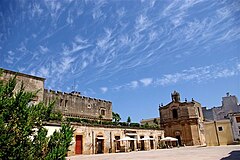San Vito dei Normanni
| San Vito dei Normanni | ||
|---|---|---|

|
|
|
| Country | Italy | |
| region | Apulia | |
| province | Brindisi (BR) | |
| Coordinates | 40 ° 39 ′ N , 17 ° 42 ′ E | |
| height | 108 m slm | |
| surface | 66 km² | |
| Residents | 18,881 (Dec. 31, 2019) | |
| Population density | 286 inhabitants / km² | |
| Post Code | 72019 | |
| prefix | 0831 | |
| ISTAT number | 074017 | |
| Popular name | Sanvitesi | |
| Patron saint | San Vito and San Vincenzo Ferreri | |
| Website | San Vito dei Normanni | |
San Vito dei Normanni is a town with 18,881 inhabitants (as of December 31, 2019) in the Italian province of Brindisi in Apulia .
Location and dates
San Vito dei Normanni is located about 9 km from the Adriatic coast, 20 km from Brindisi , about 55 km from Lecce and about 100 km from Bari . San Vito extends over an area of 6,636 hectares and is on average 108 meters above sea level. The highest point in the municipality is the 119 m high mountain Castello d'Alceste .
Neighboring municipalities are Brindisi , Carovigno , Francavilla Fontana , Latiano , Mesagne , Ostuni and San Michele Salentino . The Frazioni (districts) of San Vito are Conforto, Favorita, San Giacomo and San Vito Scalo.
history
In the area of San Vito, in the immediate vicinity of the city, archaeological traces of prehistoric settlements from the years 1800–1700 BC have been found. BC (burial sites with remains of 30 graves and ceramics from the early Bronze Age) and ancient times (7th and 8th centuries) found.
According to some historians, the town was founded by Schokatzen at the end of the 10th century , while other historians claim that the founding was due to the Normans (11th or 12th century), especially Bohemond of Altavilla (1050–1111), according to the stories had the square tower built around which the feudal palace was later built. The small village expanded towards the end of the Middle Ages , when the residents of the adjacent courtyards moved to San Vito, thanks to the defensive protection of the tower, in order to evade the raids of the Turks , but it was not until the 15th century that the ancient court was organized into a commune , became a fief and received royal protection.
Over the centuries the settlement was named San Vito degli Schiavoni (after the name of Slavic citizens of the Republic of Venice ) or simply San Vito in Terra d'Otranto. With the royal decree of December 13, 1863, the municipality took its current name San Vito. The President of the Republic granted the municipality of San Vito dei Normanni the designation city by the special decree of April 14, 1994.
From 1964 to 2000, the US armed forces operated a Wullenweber circular antenna system on the former military airfield of San Vito dei Normanni , which was also known as the "Coliseum" because of its size.
Population development
While there were only 4,853 Sanvitesi in 1861, at the turn of the century there were already 9,349 inhabitants. Before the Second World War , around 15,000 people lived in San Vito, in 1961 there were around 19,000 people, up to the largest population of 20,483 in 1991. Today, San Vito has 19,801 inhabitants.
Culture and sights
Buildings
Santa Maria della Vittoria
The Basilica of Santa Maria della Vittoria is the Baroque mother church of San Vito. While the baroque elements of the facade were added in the 18th century, the three-aisled church is from 1571. From 1980 to 1992 major renovations took place. On December 30th, Pope John Paul II declared the church a minor basilica . In addition to the large baroque main bronze portal, there are two bronze doors by the sculptor Ernesto Lamagna . The church altar is from 1777. There are many statues and paintings inside, including the Last Supper from 1777, the Birth of the Virgin from 1667 and Santa Maria della Vittoria from 1610.
lock
Dentice di Frasso Castle was built by Boemondo d'Altavilla in the 12th century. After the redesigns in the following epochs, only the square towers and parts of the castle wall remain.
music
The Barocco Festival takes place every year, a baroque music festival in honor of the San Vito composer Leonardo Leo .
museum
The Museo Civiltà Rurale in a monastery building from the 17th century has been showing evidence of everyday local culture and economic life from the 8th to the middle of the 20th century since 2001.
Twin cities
Personalities
- Leonardo Leo (1694–1744), baroque composer
- Vito Buonsanto (1762–1850), writer, philosopher and academic
- Vito Donato Epifani (1848–1922), writer and lawyer.
- Lanza del Vasto (1901–1981), poet and writer
- Francesco Gioia (* 1938), Catholic Archbishop
Web links
Individual evidence
- ↑ Statistiche demografiche ISTAT. Monthly population statistics of the Istituto Nazionale di Statistica , as of December 31 of 2019.
- ^ Description of the church on viaggiareinpuglia.it




